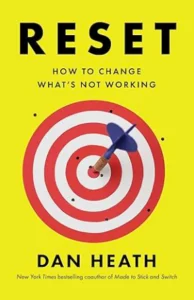We’ve all been there—watching a system, team, or workflow spin its wheels despite our best efforts. Maybe it’s a sluggish customer service process that never seems to improve, or a team meeting that feels like it exists solely to drain morale. You want change, but adding more pressure, more people, or more tools just doesn’t seem to help. If this sounds familiar, Dan Heath’s Reset: How to Change What’s Not Working might just be the playbook you didn’t know you needed.
Why This Book Matters in a Stuck World
Heath’s latest work doesn’t offer another checklist for productivity or a vague call to “think outside the box.” Instead, it’s a powerful reframing of how change actually happens inside systems that feel immovable. The core insight? You don’t need more effort—you need better effort, applied in the right places. And most of those places are hiding in plain sight.

Reset builds on the systems thinking Heath explored in his earlier solo book, Upstream, but with a sharper lens on organizations and the people trying to fix them. Where many change-management books are written for CEOs and consultants, this one speaks directly to the person inside the system—managers, team leads, teachers, nurses, ops people—who want to make things better with the resources they already have.
The Myth of More: Why Most Efforts to Fix Systems Fail
One of the first myths Heath dismantles is the idea that broken systems require more resources to function. When things aren’t working, our instinct is often to throw money or manpower at the problem. But more isn’t always better—especially when the system itself is poorly designed or misaligned.
Heath invites readers to consider “leverage points”: small pressure spots within a system where a modest, well-placed intervention can produce disproportionately large improvements. Think of it like judo—using the system’s own momentum against its inefficiencies, rather than trying to overpower it. In one case study, he shows how a hospital reduced patient bottlenecks not by adding more staff or space, but by rethinking how patients were routed through their system. The result? Faster care, less frustration, and no extra budget required.
Progress Is the Ultimate Motivator—But Few Leaders Use It
If you’ve ever felt deflated at work despite a full to-do list, you’re not alone. One of the most eye-opening points in Reset is the research-backed idea that the biggest driver of workplace motivation isn’t money or recognition—it’s progress. Yet only 5% of managers identify this as a top motivator. That disconnect explains a lot.
People thrive when they can see that their work is moving something forward. But many systems bury this progress under layers of bureaucracy or metrics that miss the point. Heath references a powerful study by Teresa Amabile and Steven Kramer, which shows that even small signs of progress can supercharge motivation. The challenge is making that progress visible.
This isn’t about handing out gold stars. It’s about redesigning feedback loops so that your team actually sees the impact of their work. That might mean changing how success is tracked, giving quicker feedback, or even just sharing “before and after” snapshots of recent improvements. When people can see that their work matters, engagement follows.
Stop Treating Every Customer Equally—Some Are Costing You
Another refreshing insight from the book is Heath’s challenge to the idea that all customers (or users or stakeholders) should be treated equally. It’s not just unrealistic—it’s bad strategy.
In one case, Heath describes a company that discovered their top 20% of customers generated 150% of their profits. That means the other 80% were either neutral—or actively dragging the business down. Instead of trying to please everyone, the company restructured its service tiers and communication strategy to better serve its most valuable users. The result wasn’t just higher profitability—it also improved internal clarity and focus.
Heath uses this to illustrate a broader truth: most systems are optimized for averages. But “average” hides everything interesting—like where things are going spectacularly right, or disastrously wrong. To reset what’s not working, you have to stop chasing the middle and start learning from the extremes.
Simple Tools, Big Shifts: Bright Spots and the Genius Swap
Reset offers a toolkit of deceptively simple but highly effective methods for driving meaningful change. Two standouts are the “Bright Spots” method and the “Genius Swap.”
Bright Spots are instances where things are already working well—despite the broken system around them. Heath encourages readers to find these outliers and ask: why did it work here? What was different? In one example, a high school counseling program found that one of their advisors was achieving remarkable results with students—by doing less. By identifying and replicating her approach, they transformed the whole department’s effectiveness.
The Genius Swap is a team exercise that starts with a single question: what part of your job do you dread? Often, what one person hates is something another actually enjoys. Swapping these tasks based on preferences can boost morale and productivity—without changing anyone’s role or compensation. It’s a low-cost, high-impact shift that can dramatically reset team dynamics.
Getting Unstuck Means Focusing on the Right Constraints
Perhaps the most liberating idea in the book is this: every system has constraints. You’re not going to eliminate them—you’re going to choose which ones matter most.
Heath encourages leaders to stop chasing the fantasy of “fixing everything” and instead zoom in on the single bottleneck that’s currently limiting progress. That’s your leverage point. Once you free up that constraint, another one will take its place—but the system as a whole will have improved.
It’s a mindset shift that replaces overwhelm with clarity. Rather than being paralyzed by a laundry list of problems, you focus on the one problem worth solving today. That’s how momentum is built—not in leaps, but in deliberate pivots.
The Real Challenge: Letting Go of What’s Comfortable
Of course, knowing what to change is only half the battle. The harder part is letting go of what feels familiar but isn’t working. That might mean scrapping a beloved report no one reads, reassigning a team lead, or rethinking your relationship with metrics.
Heath doesn’t sugarcoat it. Change is uncomfortable, especially when you’re embedded in the very system you’re trying to fix. But he offers a path forward that doesn’t rely on heroics—just clarity, humility, and the courage to ask different questions.
What Will You Reset?
Reset isn’t a manifesto. It’s a field guide—rooted in real stories, backed by research, and designed for people who are ready to act. Whether you’re managing a team, rethinking your operations, or just trying to make your work life a little more sane, Heath’s framework helps you move from frustrated to focused.
The invitation is simple: stop pushing harder. Start looking smarter. Somewhere in your process, there’s a hidden lever. Pull it, and the whole system might start to move.
If you’ve been feeling stuck, maybe it’s not your fault. Maybe it’s the system. And maybe you’re just one well-placed adjustment away from making it better.

